Abstract
Biocontrol agent (BCA) plant protection active substances composed from microorganisms, semiochemicals and substances from natural origins are increasing in Europe, since their entry into force of Regulation (EC) 1107/2009, in number and as a percentage of total active substances. As they are included in the scope of plant protection products (PPPs), this raises the question as to whether they are only substitute active substances, more socially acceptable, sustainable and environmentally preferable, or really another way of managing bioaggressors, pests and diseases. As we have conducted a survey of all active substances listed in all Parts of Regulation EU 540/2011 and compared chemical to BCA active substances, described their evolution and characteristics since 2011 and predicted the global perspective in the future years for both chemical, which are in decline, and BCA AS separately, these works raised the question of whether these BCA AS are a substitution, as is often the case for users, for the previous chemical AS, or whether they are fundamentally different new substances, which clearly obey a new vision of crop protection. This study therefore encompasses all active substances approved at any time in Europe since 2011 for both categories, whether still approved or not. At the end of this assessment, the following conclusion can be drawn: BCA AS are mainly fundamentally different substances from chemical AS, in all the compartments studied. A comparison between BCAs and chemical active substances allowed under (EC) 1107/2009 PPP Regulation is described together with a characterisation of BCA AS listed in EC 540/2011 PPP Regulation. Finally, the specific distinction of BCA vs. chemical active substance profile is analysed. This work allows us to conclude on the evolution of crop protection and the means that must be implemented to face current and new threats.
1. Introduction
BioControl Agents (BCAs) are plant protection active substances (AS) restricted to microorganisms, semiochemicals and natural substances from mineral, plant, microbial and animal origins [1]. BCAs exclude synthetic agrochemicals [2], although some semiochemicals and a few natural substances may be synthetic equivalents, therefore, the difference between BSA AS and synthetic agrochemicals is best considered as a distinction between naturally occurring substances and exogenous substances (agrochemical AS). Thus, both are employed as crop protection products, defined by an AS formulated with co-formulants, safeners or synergists. A single AS can therefore result in multiple Plant Protection Products (PPPs) with different names depending on this specific wording and sold by different companies. These PPPs can be used on various crops, various situations (in field, greenhouses or indoor) with various functions (i.e., insecticide or fungicide). This work was conducted into the active substances designed to be used for agricultural crop protection in Europe. We previously worked to characterise one side of the growing biocontrol agents’ functions, usages and their evolution since 2011 [1], then the reduction of chemical AS and their slow replacement by BCA AS [3,4], but in most regulatory situations (uses, evaluation, approval, definition of residues) they are considered completely identical, and sometimes even, some think that BCAs are only more ecological and sustainable substitutions than agrochemical AS. Some stakeholders consider this way of managing bioaggressors, pests and diseases only to be a more socially acceptable, sustainable and environmentally preferable alternative to chemical AS, while some other stakeholders consider biocontrol agent AS to be a profound change in the management of plant protection. Consequently, the data collection was updated to include all functions, crop usages, Maximum Residue Limits (MRL), affiliation in a Part (A to E) of the Implementing Regulation 540/2011) [5] for all AS approved since 2011, regardless of the mode of termination of any approvals of Plant Protection Products (PPPs) Regulation (EC) No 1107/2009 [6]: end of approvals by abandon from applicant, non-renewal or withdrawal decision from the votes of EU Member States (M.S.) at the Plant Animal Feed Food (PAFF) Committee. Thus, 581 AS were approved since 2011, divided into 240 BCA AS (41%) and 341 chemical AS (59%). The analysis of all the AS parameters described above can help to answer the question of whether BCAs are overall AS corresponding to a substitution of the declining chemical AS, or whether they really represent a new separate and different form of crop protection.
2. Materials and Methods
2.1. Legal Support
2.1.1. European Pesticides Database
The raw data were retrieved from the European Pesticides Database v3.1. This database lists all the substances approved as well as those where approval is pending and those not approved [7]. The collection method was therefore a full analysis of the PPP regulation regarding each AS regulation activity since 2011: entry in vigour, extension of the expiration date, renewal and non-renewal, end of approval, changes of regulatory status, type of AS or residue management. The status of the active substances in this database is crucial since no regulations are involved when AS are only subjected to “end of approval” abandoned by the applicant, thus without specific regulation. Further calculations were carried out from this constituted database like total number of AS, chemical AS, BCA AS, AS and residue type, BCA category, BCA over chemical AS ratio and their evolution through time.
2.1.2. Directives and Regulations
Regulation (EC) No 1107/2009 [6] is the main and original document dealing with PPPs and substances (pesticides) since 2009. Implementing Regulation (EU) No 540/2011 [5,8] is the main companion of the PPP regulation as it regards the list of approved active substances. Basic substances are approved according to Article 23 of Regulation (EC) No 1107/2009 and listed in Part C. Low-risk substances (LR) [9] are approved according to Article 22 of Regulation (EC) No 1107/2009 and listed in Part D. Substance candidates for substitution (CFS) are approved according to Article 24 of Regulation (EC) No 1107/2009 and are listed in Part E [10].
Following this, Regulation (EC) No 396/2005 [11] manages the rules on maximum residue levels of pesticides in or on food as well as plant and animal feed.
Subsequently, all the information on one active substance is centralized in the pesticide database, including review reports that contain the GAP usage tables dedicated to field applications. Agricultural uses [12] or usages in plant protection are defined by cultivation practices and roughly managed by the coupled crop vs. bioagressor (insect/pathogen), linked to function, and are listed in the corresponding Good Agricultural Practices (GAP) Table in the Review Reports in the EU Pesticide database [7]. When available, other uses were collected from Members States (M.S.) national databases.
2.2. Definitions
All definitions were previously defined for agrochemicals [2].
3. Results
3.1. Functions as Crop Protection of BCA vs. Chemical AS
The usages corresponding to both BCA [13] and chemical AS approved since 2011 are depicted in Figure 1. Fungicides, insecticides and herbicides are the main functions covered by all AS, but while the chemical AS (plain black) mainly occupy the herbicide, fungicide and insecticide functions, the BCA AS (black hatched) mainly occupy the fungicide, insecticide and attractant functions.
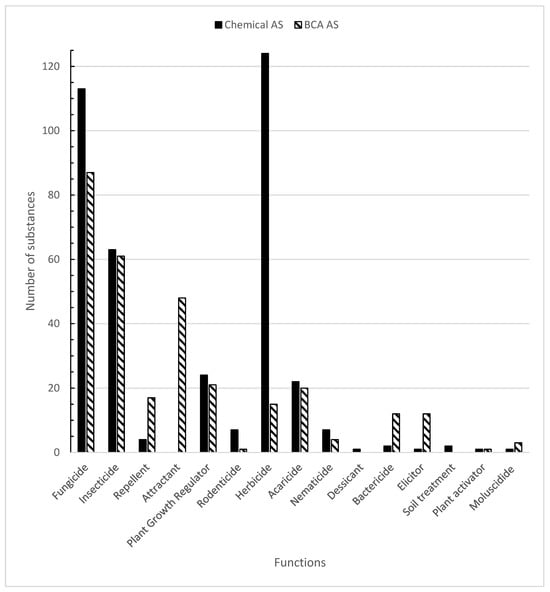
Figure 1.
Crop function associated with BCA and chemical AS.
3.2. Crop Function of BCA vs. Chemical AS
Perennial crops (viticulture, arboriculture and horticulture) show little difference in consideration between BCA and chemical AS, but annual crops (market gardening, cereals and arable crops) are mainly targeted by chemical AS. It should be noted that a single culture (arboriculture) is considered slightly predominant via BCA AS, as illustrated in Figure 2.
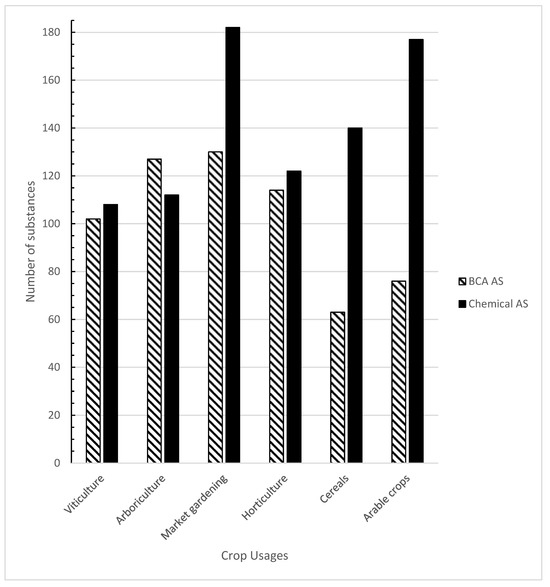
Figure 2.
Crop usages associated with BCA and chemical AS.
3.3. Maximum Residue Limits (MRLs) Associated with BCA and Chemical AS
MRL are defined by Regulation (EC) 396/2005 [11] and divided into three classes, and according to our previous work, they show high differences between Annexes IV and V and similarity between Annexes II and III and can be grouped into a single class [14]. These classes are for substances without MRL (Annex VI) (Class 0), with MRL by default (V) (Class 1) and assigned MRL in Annexes II or III (Class 2). A global examination of the results displayed in Figure 3 shows a significant difference between chemical and BCA AS regarding MRL distribution in the three classes previously described. The order of importance of MRLs is completely reversed in a clear manner, in favour of substances without residues (Annexe IV) for BCA AS and to the detriment of substances with residues under surveillance (Annexes II and III) for chemical AS. This is not only for the proportions, but for increases in weight by the larger number of chemical AS.
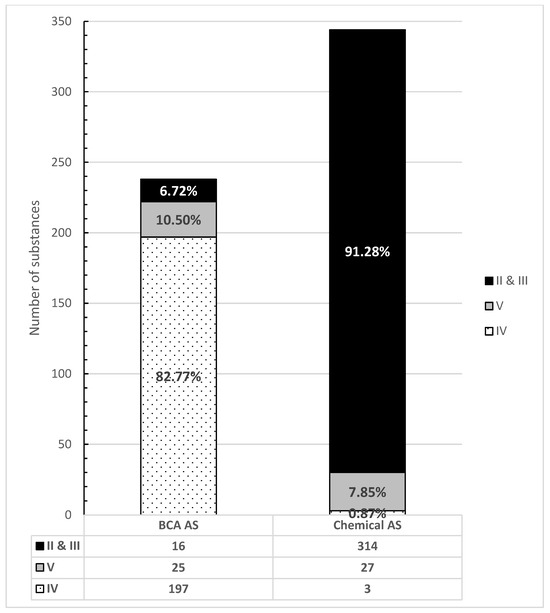
Figure 3.
Repartition of MRLs associated with BCA and chemical AS.
In Figure 3, the first column displays the initial situation for BCA AS with a majority of AS with no MRL and a high number of AS with MRL by default. Column 2 on the contrary shows a high prevalence of AS with MRLs for Chemical AS. However, MRLs cannot be confused with global eco-toxicology of the AS, since several BCA AS have a greater eco-toxicological impact than some chemical AS, because of higher quantities (kg/ha) and frequency of application.
3.4. Regulatory Aspects of the BCA vs. Chemical AS
All AS substances, regardless of their initial approval duration, have a longer life than the initial approval for two reasons, i.e., extensions of the approval duration or renewal.
Extensions of the approval period (in Figure 4) for all AS occurs when the assessment is not completed at renewal as the SA approval period is coming to an end. In this case, the PAFF Committee postpones the end date of approval usually by one year or occasionally two years.
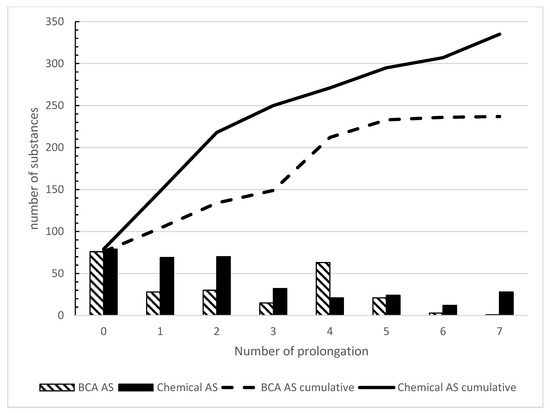
Figure 4.
Extensions of the approval period for BCA vs. chemical AS.
It is significant that the delays in the evaluations lead to extensions of up to seven years! However, relatively few extensions exceed 4 years for BCA AS, as shown in Figure 5. It is remarkable that the extensions affect the chemical AS more than the BCA AS, but they are also more numerous (341 vs. 240).

Figure 5.
Number of renewals for BCA vs. chemical AS.
It should be noted that chemical AS are much more subject to non-renewal than BCA AS, and conversely, BCA AS are more subject to renewal than chemical AS, in addition to the fact that far more chemical substances have been approved in total. Furthermore, extremely few substances (in Figure 4) in twelve years have been renewed twice, knowing that the initial approval is generally for 10 years or more.
3.5. Regulatory Repartitions of the BCA vs. Chemical AS
3.5.1. Repartition in AS Categories
Controversial substances (i.e., candidates for substitution (CFS) AS), are much more prevalent in chemical AS (in Figure 6) [10], compared to BCA AS; however, AS with less concern (i.e., low-risk or basic AS) are only represented by BCA AS (Figure 7) [9,15,16,17].
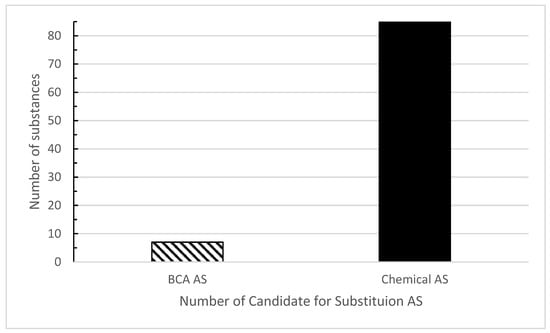
Figure 6.
Candidates for substitution (CFS) AS in BCA vs. chemical AS.
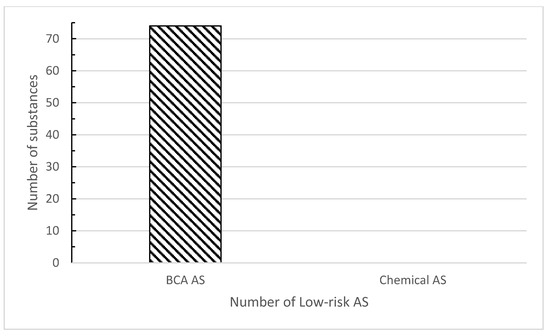
Figure 7.
Low-risk AS in BCA vs. chemical AS.
3.5.2. Repartition of BCA and Chemical AS in Regulation 540/2011 Parts
The modification of substances positions in the different Parts (A to E) of Regulation 540/2011 [18] due to regulatory movements and the assignments for the BCA and chemical AS are exhibited in Figure 8. The corresponding assignment is really different for BCA AS than chemical AS, directly linked to the characteristics of the matching AS.
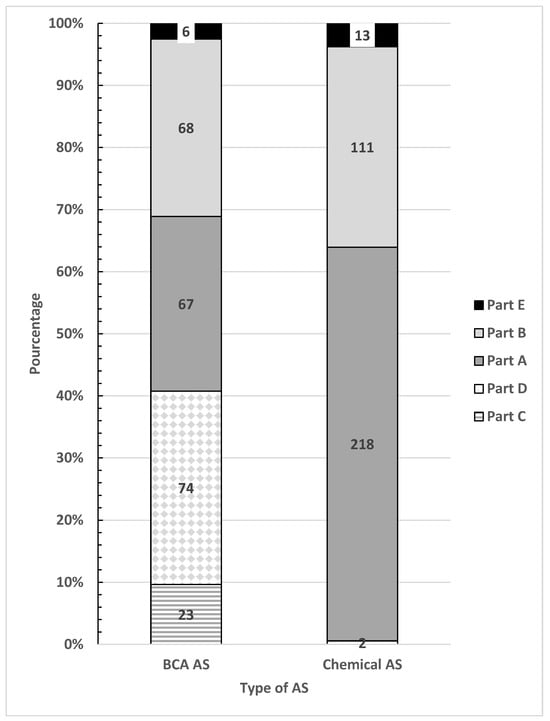
Figure 8.
Repartition of BCA vs. chemical AS in Parts of Implementing Regulation 540/2011.
3.5.3. Increase in BCA AS
Following the initial situation where BCAs were considered as AS substitutions for chemical AS, it should be noted that until the end of 2022, the increase in BCA AS was relatively significant, regular and still positive, but at the beginning of 2023 we observe a stagnation of precise abandonment (end of approval without a regulatory event), which is typically what our database is capable of tracking, knowing that the updating of the Pesticide database is quite slow. The corresponding evolution of BCA AS is exhibited in Figure 9, showing not only the level but also a decline in BCA AS in 2023. It is therefore appropriate to confirm that the (regulatory) movements of the BCAs definitely do not correspond to organized “replacements” because they do not correspond in particular to the same functions.
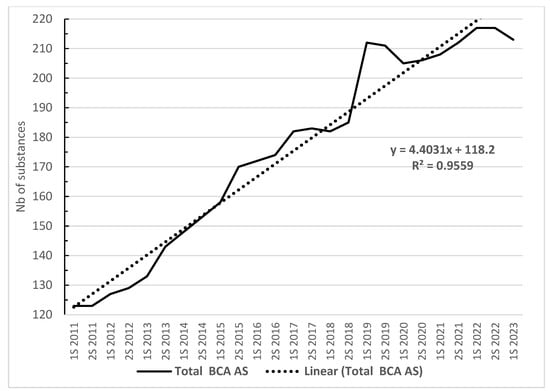
Figure 9.
Evolution of BCA AS amount since 2011.
This situation changes the results previously published, in particular the slope of the linear regression line, which goes from almost 5 to a value of 4.4, showing a clear decline.
Concomitantly, we analysed the percentage of BCA AS compared to total AS [1]. Considering the progression until the end of 2022, it was expected that this value would exceed 50%, considering the loss of numerous chemical AS. Unfortunately, many BCA AS have been abandoned, with the approval of biocontrol substances being almost all renewed when they are supported by the applicant. As exhibited in Figure 10, the increase in the % of BCA, was around +1% per year until the end of 2022 and predicted to exceed 50% in 2023; however, considering the abandoned BCA substances in early 2023, this slope is currently regressing overall to 0.81% per year over 12 years. Many BCA microorganisms scheduled for voting at the end of 2023/beginning of 2024 may change this fact, because there are few non-renewals of chemical AS to come.
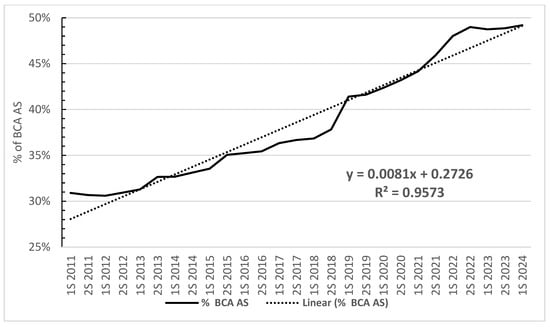
Figure 10.
Evolution of BCA AS vs. total AS ratio since 2011.
4. Discussion
4.1. Similarities and Differences between BCA and Chemical AS
As a preamble, it is important to note that the analyses were carried out on all the AS approved since 2011 in Regulation (EC) 1107/2009 and listed in Regulation EU 540/2011, therefore on a set of approved substances, but all from the same time/period and evolution as previously described [4]. This sum total of AS is 581, compared to the current maximum ever approved at any given time of 502 AS [1].
Both BCA and chemical AS are active substances in the EU PPP Regulation and exhibit a presence in the same sections for most of the figures (Figure 1, Figure 2, Figure 3, Figure 4, Figure 5, Figure 6, Figure 7 and Figure 8), except for low-risk AS (Figure 7), but the differences are sometimes very significant [4]. Only the crop usages (Figure 2) are similar, at least for their profile; however, it is clear that annual crops (market gardening, cereals and arable crops) are largely underrepresented for BCA AS. In the end, considering the eight compartments studied, few similarities emerge.
As a result of these weak similarities, it is clear that the general profiles of the two types of AS (BCA and chemical) are very different (Figure 1, Figure 4, Figure 5 and Figure 8) and sometimes even opposite (Figure 3, Figure 6 and Figure 7). With regard to the profiles with large differences between BCA and chemical AS, it can be noted that as in Figure 1, entire functions are almost exclusively occupied by chemical AS such as herbicides; while in contrast, certain functions like attractant, elicitor or repellent are predominantly monopolized by BCA AS. Figure 7 is very evolutive since the important decrease (85 AS) in chemical AS started in 2018 and the rapid increase in Part D for BCA AS.
Later, in Figure 2, as explained above, crop annuals are to a much lesser extent the target of BCA AS. Furthermore, in Figure 2, considering the MRLs, the two situations are totally opposite; many substances of concern are chemical AS, while a large majority of substances without residues are BCA AS. This is further demonstrated by Figure 6 and Figure 7, which show no low-risk substances AS for chemical AS and only a few candidates for substitution (CFS) AS (mainly copper compounds) for BCA AS. These characteristics induce the observable results in Figure 5, with many BCA AS being renewed, while many chemical AS were not. On the other hand, such evaluations are becoming more complicated and restrictive, the renewal (or non-renewal) takes longer and explains the greater number of extensions of the approval period (Figure 4) for chemical than BCA AS, although not all BCA are renewed. All these regulatory events resulting in the distinction between these two categories of substances (BCA and chemical AS) explain the classification in Figure 8 in the different Parts of Implementing Regulation EU 540/2011 [8].
4.2. BCA and Chemical AS: Different Types of Substances
In addition, the two types of active substances are indeed from two different types of substances in terms of their origin. Chemical AS are on the one hand from synthetic origin, and BCA AS on the other hand are from the three biocontrol pillars [19], from natural origin (plant, mineral, microbial, animal), microorganisms and semiochemicals; although, chemical AS used in traps are validated as BCA AS for plant protection, and some BCA AS are synthetic equivalents of natural molecules (i.e., semiochemicals). Similarly, AS assimilated as chemical substances such as acetic acid or hydrogen peroxide also exist in nature [20]. BCA AS are more dedicated and easily justifiable for Integrated Pest Managment (IPM), although chemical AS are allowed [21].
5. Conclusions and Perspectives
Following all these analyses, a comparison between BCA and chemical AS clearly shows significant differences in all the fields considered, but in addition to the very different origin of these AS, their field and mode of action their specificities (mainly for BCA AS compared to chemical AS on average with a broader spectrum) place them in two different or even opposing families. We are therefore dealing with two very different types of substances, corresponding to two different concepts, even if occasionally, they can be or appear as substitute biosolutions/biorationals. The curative model with its weaknesses, concentrating criticism and mobilizing surveillance, on the one hand, mainly groups chemical AS and BCA AS with very different principles and Modes of Action (MOA), mainly as host specificity, and has a better durability [13]. Globally, BCA AS are applied rather preventively and chemical AS rather curatively; mostly due to compositions of these PPPs, BCA are more intended for contact and chemical AS are generally penetrating and/or systemic.
These major conclusions should be understated by, on the one hand, chemical AS used with no impact on the environment [20] and BCA AS subject to criticism (i.e., the small number of CFS, broad-spectrum natural insecticides), which are undoubtedly doomed to extinction. The latter are moreover often ignored or decried by the biocontrol community itself. We can therefore firmly conclude the protection of plants, even if the BCA AS depend on the same Regulation (EC) 1107/2009 concerning PPPs, w hich these BCA AS obey, even in this context, and mechanisms of a completely different paradigm. It should be noted that the inclusion/approval of these BCA AS in the PPP regulation is quite difficult [3], because the assessment methodologies were formatted for chemical substances and have clearly not been sufficiently adapted for biological material. Recent and ongoing modifications to assess these biological materials differently and in particular microorganisms [22,23,24,25] are, after the modification of the criteria for low-risk substances [26], strong signals in favour of BCA AS [27,28]. The conclusion is that the BCA AS are quite dissimilar to the old chemical substances for all registered items being considered (type, status, human toxicology, ecotoxicology and environmental impact, maximum residue limits, mode of action, aptitude for renewal and finally durability and AS lifespan). However, due to the reduction of chemical AS due to non-renewal and withdrawals, the absence of validation of new chemical AS and the increase in BCA AS, it is clear that the vision of “replacement” that external observers will retain will always be biased by the inexorable increase in the BCA AS vs. total AS ratio [29]. At the end of this process, it will therefore be “technically” proven that the BCA AS have “replaced” the chemical AS, and that the theory of the “ecological substitution” of the AS, initially felt, is validated. In any case, the functions of these AS, almost exclusively BCA AS, will be largely different from the functions of the initial chemical AS. This will be further reinforced by the fact that the arriving BCAs will also fulfil traditional chemical AS functions such as herbicides (i.e., Verticillium nonalfafae strain Vert56); this latest BCA AS shaking up the usual dogma in production in Organic Agriculture (OP) that microorganisms are all acceptable and accepted, and that herbicides are not valid in OP.
All these points and considerations reinforce the ongoing request for the inclusion of “Biocontrol” (concept, definition, scope) in the PPP regulation [6] and the proposal [30] for a new EU Regulation on Sustainable Use of PPPs (abbrev. SUR) and a specific adjoining processing pathway (including the provision of documentation files, waivers, fees, evaluation, process timing and AS lifetime).
Funding
This research was funded by the national funds of the French Ministries of Ecology and Agriculture through Office Français de la Biodiversité/Ecophyto (Biocontrol 2012-2013-17B-80, XP-BC ACTA 2017-022, Biocontrol’Expansion 2019-2021-AFB-362) and Plan de Relance (RACAM ACTA 2021-219).
Institutional Review Board Statement
Not applicable.
Informed Consent Statement
Not applicable.
Data Availability Statement
Non-public data.
Conflicts of Interest
The author declares no conflict of interest.
References
- Robin, D.C.; Marchand, P.A. Evolution of the biocontrol active substances in the framework of the European Pesticide Regulation (EC) No. 1107/2009. Pest Manag. Sci. 2019, 75, 950–958. [Google Scholar] [CrossRef] [PubMed]
- Marchand, P.A. EU chemical plant protection products in 2023: Current state and perspectives. Agrochemicals 2023, 2, 106–117. [Google Scholar] [CrossRef]
- Vekemans, M.-C.; Marchand, P.A. The fate of the BioControl Agents under the European Phytopharmaceutical Regulation: A hindering for approval botanicals as new active substances? Environ. Sci. Pollut. Res. 2020, 27, 39879–39887. [Google Scholar] [CrossRef] [PubMed]
- Marchand, P.A. Evolution of plant protection active substances in Europe: Disappearance of chemicals in favour of biocontrol agents. Environ. Sci. Pollut. Res. 2023, 30, 1–17. [Google Scholar] [CrossRef]
- EU. Commission Implementing Regulation (EU) No 540/2011 of 25 May 2011 implementing Regulation (EC) No 1107/2009 of the European Parliament and of the Council as regards the list of approved active substances. Off. J. Eur. Union 2011, L153, 133–319. [Google Scholar]
- EC. Regulation (EC) No 1107/2009 of the European Parliament and of the Council of 21 October 2009 concerning the placing of plant protection products on the market and repealing Council Directives 79/117/EEC and 91/414/EEC. Off. J. Eur. Union 2009, L309, 1–50. [Google Scholar]
- EU. EU Pesticides Database v3.1. 2023. Available online: https://ec.europa.eu/food/plant/pesticides/eu-pesticides-database/start/screen/active-substances (accessed on 7 September 2023).
- Robin, D.; Marchand, P.A. Evolution of Regulation (EU) No 540/2011 since its entry into force. J. Regul. Sci. 2019, 7, 1–7. [Google Scholar] [CrossRef]
- Robin, D.C.; Marchand, P.A. Expansion of the low-risk substances in the framework of the European Pesticide Regulation (EC) No. 1107/2009. Eur. J. Risk Regul. 2022, 13, 514–531. [Google Scholar] [CrossRef]
- Robin, D.C.; Marchand, P.A. The slow decrease of the active substances candidates for substitution in the framework of the European Pesticide Regulation (EC) No. 1107/2009. Eur. J. Risk Regul. 2022, 14, 191–212. [Google Scholar] [CrossRef]
- EC. Regulation (EC) No 396/2005 of the European Parliament and of the Council of 23 February 2005 on maximum residue levels of pesticides in or on food and feed of plant and animal origin and amending Council Directive 91/414/EEC. Off. J. Eur. Union 2005, L70, 1–16. [Google Scholar]
- WHO. #309 GAP Table. Good Agricultural Practices (GAP) Table. 2023. Available online: https://www.fao.org/pesticideregistration-toolkit/registration-tools/data-requirements-and-testing-guidelines/study-detail/en/c/1186124/ (accessed on 25 September 2023).
- Bardin, M.; Pugliese, M. Biocontrol Agents Against Diseases. In Integrated Pest and Disease Management in Greenhouse Crops; Gullino, M., Albajes, R., Nicot, P., Eds.; Plant Pathology in the 21st Century; Springer: Cham, Switzerland, 2020; Volume 9. [Google Scholar] [CrossRef]
- Charon, M.; Robin, D.; Marchand, P.A. The major interest for crop protection of agrochemical substances without maximum residue limit (MRL). Biotechnol. Agron. Soc. Environ. 2019, 23, 22–29. [Google Scholar] [CrossRef]
- Villaverde, J.J.; Sevilla-Morán, B.; Sandín-España, P.; López-Goti, C. and Alonso-Prados, J.L. Biopesticides in the framework of the European Pesticide Regulation (EC) No. 1107/2009. Pest Manag. Sci. 2014, 70, 2–5. [Google Scholar] [CrossRef] [PubMed]
- Marchand, P.A. Basic substances: An opportunity for approval of low-concern substances under EU pesticide regulation. Pest Manag. Sci. 2015, 71, 1197–1200. [Google Scholar] [CrossRef] [PubMed]
- Romanazzi, G.; Orçonneau, Y.; Moumni, M.; Davillerd, Y.; Marchand, P.A. Basic substances, a sustainable tool to complement and eventually replace synthetic pesticides in the management of pre and postharvest diseases: Reviewed instructions for users. Molecules 2022, 27, 3484. [Google Scholar] [CrossRef] [PubMed]
- Wulf, F.; Podhorna, J.; Bandte, M.; Büttner, C.; Rybak, M. The use of stinging nettle tea (Urtica sp.) to control Aulacorthum solani and Macrosiphum euphorbiae on Ranunculus asiaticus. Folia Horticulturae 2023, 35, 1–10. [Google Scholar] [CrossRef]
- Robin, D.C.; Merlet, L.; Marchand, P.A. Regulatory aspects of the Biocontrol. In Biocontrol of Plant Disease, Recent Advance and Prospects in Plant Protection; Prigent-Combaret, C., Dumas, B., Eds.; Ecosystems and Environment, Environments; ISTE: London, UK; Wiley: Hoboken, NJ, USA, 2023; pp. 1–17. ISBN 9781789450989. [Google Scholar]
- Marchand, P.A. Synthetic Agrochemicals: A necessary clarification about their use exposure and impact in Crop Protection. Environ. Sci. Pollut. Res. 2019, 26, 17996–18000. [Google Scholar] [CrossRef]
- Matyjaszczyk, E.; Skrzecz, I. How European Union accession and implementation of obligatory integrated pest management influenced forest protection against diseases and weeds: A case study from Poland. Crop. Prot. 2020, 127, 104986. [Google Scholar] [CrossRef]
- EU. Commission Regulation (EU) 2022/1439 of 31 August 2022 amending Regulation (EU) No 283/2013 as regards the information to be submitted for active substances and the specific data requirements for micro-organisms. Off. J. Eur. Union 2022, L227, 8–16. [Google Scholar]
- EU. Commission Regulation (EU) 2022/1440 of 31 August 2022 amending Regulation (EU) No 284/2013 as regards the information to be submitted for plant protection products and the specific data requirements for plant protection products containing micro-organisms. Off. J. Eur. Union 2022, L227, 38. [Google Scholar]
- EU. Commission Regulation (EU) 2022/1441 of 31 August 2022 amending Regulation (EU) No 546/2011 as regards specific uniform principles for evaluation and authorisation of plant protection products containing micro-organisms. Off. J. Eur. Union 2022, L227, 70. [Google Scholar]
- Helepciuc, F.-E.; Todor, A. Improving the Authorization of Microbial Biological Control Products (MBCP) in the European Union within the EU Green Deal Framework. Agronomy 2022, 12, 1218. [Google Scholar] [CrossRef]
- EU. Commission Regulation (EU) 2017/1432 of 7 August 2017 amending Regulation (EC) No 1107/2009 of the European Parliament and the Council concerning the placing of plant protection products on the market as regards the criteria for the approval of low-risk active substances. Off. J. Eur. Union 2022, L205, 59. [Google Scholar]
- Feldmann, F.; Pandey, A.K.; Rajabpour, A.; Stadnik, M.J.; Matyjaszczyk, E. Botanical active substances: A prospering field of research. J. Plant Dis. Prot. 2023, 130, 439–441. [Google Scholar] [CrossRef]
- Matyjaszczyk, E. Correction: Legislative situation of botanicals used in plant protection in the European Union. J. Plant Dis. Prot. 2023, 130, 443–447. [Google Scholar] [CrossRef]
- Marchand, P.A. Biocontrol Active Substances in Europe: A Slow Shift Towards Dominance. Chron. Bioresour. Manag. 2023, 7, 21–23. [Google Scholar]
- EU. Proposal for a Regulation of the European Parliament and of the Council on the Sustainable Use of Plant Protection Products and Amending Regulation (EU) 2021/2115. COM/2022/305 Final, 1–71. 2022. Available online: https://eur-lex.europa.eu/legal-content/EN/TXT/PDF/?uri=CELEX:52022PC0305&from=EN (accessed on 15 October 2023).
Disclaimer/Publisher’s Note: The statements, opinions and data contained in all publications are solely those of the individual author(s) and contributor(s) and not of MDPI and/or the editor(s). MDPI and/or the editor(s) disclaim responsibility for any injury to people or property resulting from any ideas, methods, instructions or products referred to in the content. |
© 2023 by the author. Licensee MDPI, Basel, Switzerland. This article is an open access article distributed under the terms and conditions of the Creative Commons Attribution (CC BY) license (https://creativecommons.org/licenses/by/4.0/).